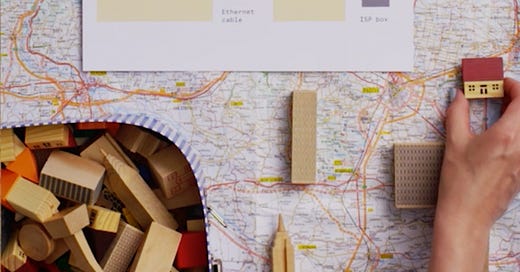No. 19 - Hajimete no Otsukai 💠 Shape of stories ⛏️ Software archeology
When we close down the wilderness, we close down imagination.
My name is Linda. I write a bi-weekly newsletter about computer science, childhood and culture - and there are 9452 of you listening. If you enjoy this issue, please share it with anyone you think may find it useful. This essay first appeared in Blue Wings back in 2018.
One of the most beloved Finnish traditions is what we call “everyman’s right,” or the use of forests as public commons. Everyone has the right to roam, wander, collect berries, and get lost in the wilderness. This, together with our safe cities, has made it possible for Finnish children to be so adventurous and self-sufficient at such an early age.
And that freedom isn’t only true of cities and forests. As a kid of the 1990s, I was allowed to surf around the internet freely. The internet of my childhood is gentle and anonymous. It’s the internet of unfinished, homemade websites and the freedom to try on twelve different identities before breakfast. The browser’s home button was always the final leash that would pull me back to safety from my cyber-adventures.
The world and the internet have changed since my childhood. Kids today need to learn how to navigate a more commercial internet full of apps, ads, and real threats. Cities, too, in many parts of the world are unsafe, which is restricting children’s right to roam freely. A Natural England report by Dr William Bird famously showed how in four generations the area where a Sheffield child was allowed to walk unaccompanied shrank from almost 10 kilometres to less than 300 metres.
Today’s kids have nowhere to go where they aren’t followed, tracked, and logged – and this applies both online and in the urban space. The current world of technology is a tale of commercialisation and fear. I went surfing one day in an effort to rekindle my childhood excitement of being able to go anywhere and be anyone at the click of a mouse, but all I found were uniform Instagram photos and warnings for parents. Three threats that lurk online. Ten ways to safeguard your child from the Internet. The World Wild Web has turned into a tame playground.
Sure, young children should not go online alone. They shouldn’t trust everyone. But when we close down the wilderness, we close down imagination.
Luckily inspiration for self-sufficiency can still be found in unlikely places. Hajimete No Otsukai (or はじめてのおつかい) is a beloved Japanese TV series about children as young as two running their first errands in their neighbourhood. The camera crew secretly follows as the tiny humans make choices about crossing the busy streets, picking up flowers and tofu at the grocery store, or bringing a missing hat to a big sister in school.
It’s exciting and scary to watch the children overcome obstacles that are both physical and emotional. Through manageable tasks, the children develop self-reliance, and a sense of social trust.
I hope Hajimete No Otsukai can be an inspiration for the next generation making their way in the world, whether in a natural, urban, or digital context. After all, it is only through browsing, meandering, wandering, and exploring that we learn to find what we’re looking for.
Try out an activity called Hiding in Plain Sight, which combines walking in a city with finding the Internet!
Linked List
For the past years I’ve been trying to be aware of who tells the stories I read and include non-Western writers in the mix. This lovely article by Kim Yoon Mi maps shapes of stories, and spoiler, not all of them have to do with conflict or hero’s journey. Makes me think of Our Fairy Tales, Ourselves: Storytelling from East to West from 2016. It inspired me to read the book Haruki Murakami Goes to Meet Hayao Kawai.
Two things that feel like they belong together and one day I’ll maybe make the connection: Finding the Mother Tree - interview of Suzanne Simard and the Wikipedia article on Software archaeology
Classroom
I’m hoping to surface and share stories from all of you and I’d love to see your creations!
Inspired by last week’s pancake algorithm, Milena and her child made a video + cardboard version of it. Do click - the video is great and I love this kind of creativity.
Emilie reviews STEAM books - very honored to be on her list. The rest of the recommendations are wonderful too!
A nice twist on the Dataselfie activity.


..And some in-real-world bit penguins!










